technical data FIAT FIORINO 2017 Owner handbook (in English)
[x] Cancel search | Manufacturer: FIAT, Model Year: 2017, Model line: FIORINO, Model: FIAT FIORINO 2017Pages: 272, PDF Size: 5.87 MB
Page 216 of 272
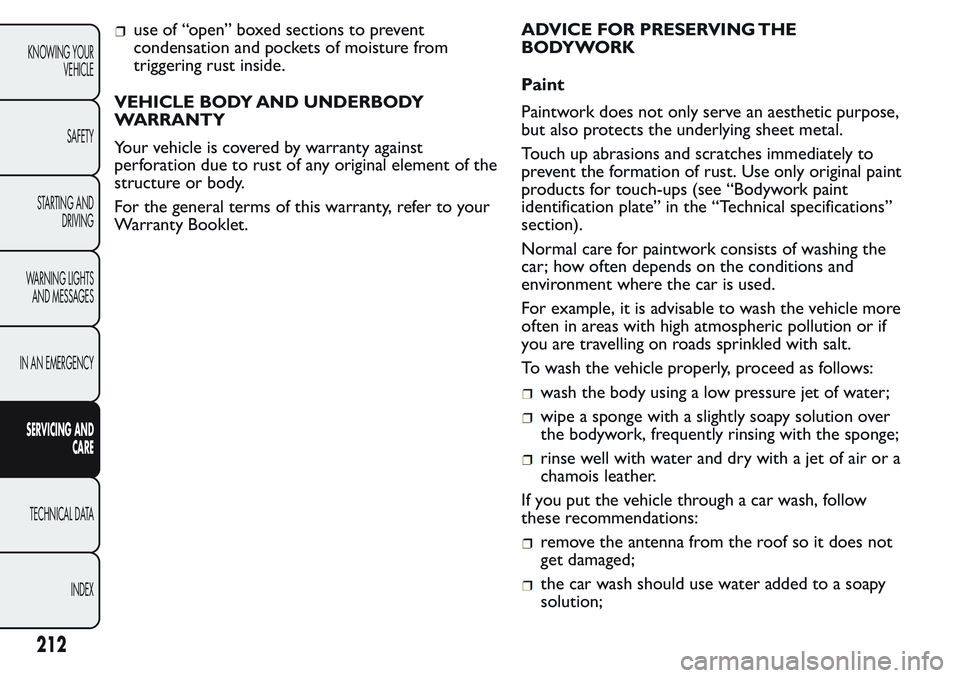
use of “open” boxed sections to prevent
condensation and pockets of moisture from
triggering rust inside.
VEHICLE BODY AND UNDERBODY
WARRANTY
Your vehicle is covered by warranty against
perforation due to rust of any original element of the
structure or body.
For the general terms of this warranty, refer to your
Warranty Booklet.ADVICE FOR PRESERVING THE
BODYWORK
Paint
Paintwork does not only serve an aesthetic purpose,
but also protects the underlying sheet metal.
Touch up abrasions and scratches immediately to
prevent the formation of rust. Use only original paint
products for touch-ups (see “Bodywork paint
identification plate” in the “Technical specifications”
section).
Normal care for paintwork consists of washing the
car; how often depends on the conditions and
environment where the car is used.
For example, it is advisable to wash the vehicle more
often in areas with high atmospheric pollution or if
you are travelling on roads sprinkled with salt.
To wash the vehicle properly, proceed as follows:
wash the body using a low pressure jet of water;
wipe a sponge with a slightly soapy solution over
the bodywork, frequently rinsing with the sponge;
rinse well with water and dry with a jet of air or a
chamois leather.
If you put the vehicle through a car wash, follow
these recommendations:
remove the antenna from the roof so it does not
get damaged;
the car wash should use water added to a soapy
solution;
212
KNOWING YOUR
VEHICLE
SAFETY
STARTING AND
DRIVING
WARNING LIGHTS
AND MESSAGES
IN AN EMERGENCY
SERVICING AND
CARE
TECHNICAL DATA
INDEX
Page 217 of 272
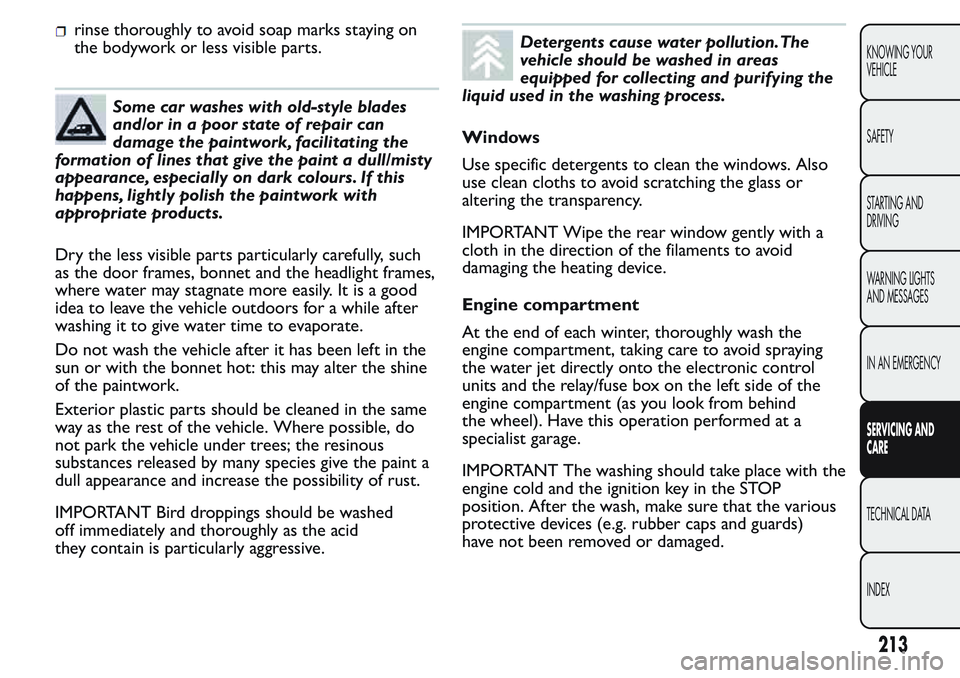
rinse thoroughly to avoid soap marks staying on
the bodywork or less visible parts.
Some car washes with old-style blades
and/or in a poor state of repair can
damage the paintwork, facilitating the
formation of lines that give the paint a dull/misty
appearance, especially on dark colours. If this
happens, lightly polish the paintwork with
appropriate products.
Dry the less visible parts particularly carefully, such
as the door frames, bonnet and the headlight frames,
where water may stagnate more easily. It is a good
idea to leave the vehicle outdoors for a while after
washing it to give water time to evaporate.
Do not wash the vehicle after it has been left in the
sun or with the bonnet hot: this may alter the shine
of the paintwork.
Exterior plastic parts should be cleaned in the same
way as the rest of the vehicle. Where possible, do
not park the vehicle under trees; the resinous
substances released by many species give the paint a
dull appearance and increase the possibility of rust.
IMPORTANT Bird droppings should be washed
off immediately and thoroughly as the acid
they contain is particularly aggressive.
Detergents cause water pollution.The
vehicle should be washed in areas
equipped for collecting and purifying the
liquid used in the washing process.
Windows
Use specific detergents to clean the windows. Also
use clean cloths to avoid scratching the glass or
altering the transparency.
IMPORTANT Wipe the rear window gently with a
cloth in the direction of the filaments to avoid
damaging the heating device.
Engine compartment
At the end of each winter, thoroughly wash the
engine compartment, taking care to avoid spraying
the water jet directly onto the electronic control
units and the relay/fuse box on the left side of the
engine compartment (as you look from behind
the wheel). Have this operation performed at a
specialist garage.
IMPORTANT The washing should take place with the
engine cold and the ignition key in the STOP
position. After the wash, make sure that the various
protective devices (e.g. rubber caps and guards)
have not been removed or damaged.
213
KNOWING YOUR
VEHICLE
SAFETY
STARTING AND
DRIVING
WARNING LIGHTS
AND MESSAGES
IN AN EMERGENCY
SERVICING AND
CARE
TECHNICAL DATA
INDEX
Page 218 of 272

Front headlights
IMPORTANT Never use aromatic substances (e.g.
petrol) or ketenes (e.g. acetone) for cleaning the
plastic lenses of the front headlights.INTERIORS
Check regularly that water is not trapped under the
mats (from dripping off shoes, umbrellas, etc.) which
could cause the metal to rust.
WARNING
Never use flammable products, such as
petroleum ether or modified petrol,
to clean the inside of the vehicle.The
electrostatic charges which are generated by
rubbing during the cleaning operation may
cause a fire.
WARNING
Do not keep aerosol cans in the vehicle:
these could explode. Aerosol cans must
not be exposed to temperatures of more than
50°C .When the vehicle is exposed to sunlight ,
the temperature inside can greatly exceed
this value.
214
KNOWING YOUR
VEHICLE
SAFETY
STARTING AND
DRIVING
WARNING LIGHTS
AND MESSAGES
IN AN EMERGENCY
SERVICING AND
CARE
TECHNICAL DATA
INDEX
Page 219 of 272
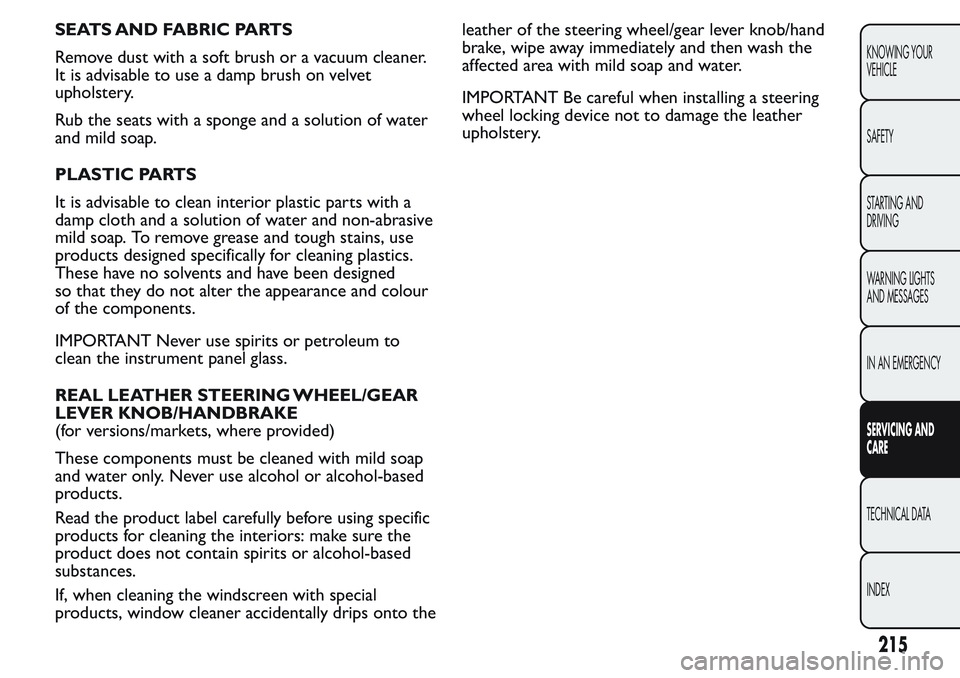
SEATS AND FABRIC PARTS
Remove dust with a soft brush or a vacuum cleaner.
It is advisable to use a damp brush on velvet
upholstery.
Rub the seats with a sponge and a solution of water
and mild soap.
PLASTIC PARTS
It is advisable to clean interior plastic parts with a
damp cloth and a solution of water and non-abrasive
mild soap. To remove grease and tough stains, use
products designed specifically for cleaning plastics.
These have no solvents and have been designed
so that they do not alter the appearance and colour
of the components.
IMPORTANT Never use spirits or petroleum to
clean the instrument panel glass.
REAL LEATHER STEERING WHEEL/GEAR
LEVER KNOB/HANDBRAKE
(for versions/markets, where provided)
These components must be cleaned with mild soap
and water only. Never use alcohol or alcohol-based
products.
Read the product label carefully before using specific
products for cleaning the interiors: make sure the
product does not contain spirits or alcohol-based
substances.
If, when cleaning the windscreen with special
products, window cleaner accidentally drips onto theleather of the steering wheel/gear lever knob/hand
brake, wipe away immediately and then wash the
affected area with mild soap and water.
IMPORTANT Be careful when installing a steering
wheel locking device not to damage the leather
upholstery.
215
KNOWING YOUR
VEHICLE
SAFETY
STARTING AND
DRIVING
WARNING LIGHTS
AND MESSAGES
IN AN EMERGENCY
SERVICING AND
CARE
TECHNICAL DATA
INDEX
Page 220 of 272
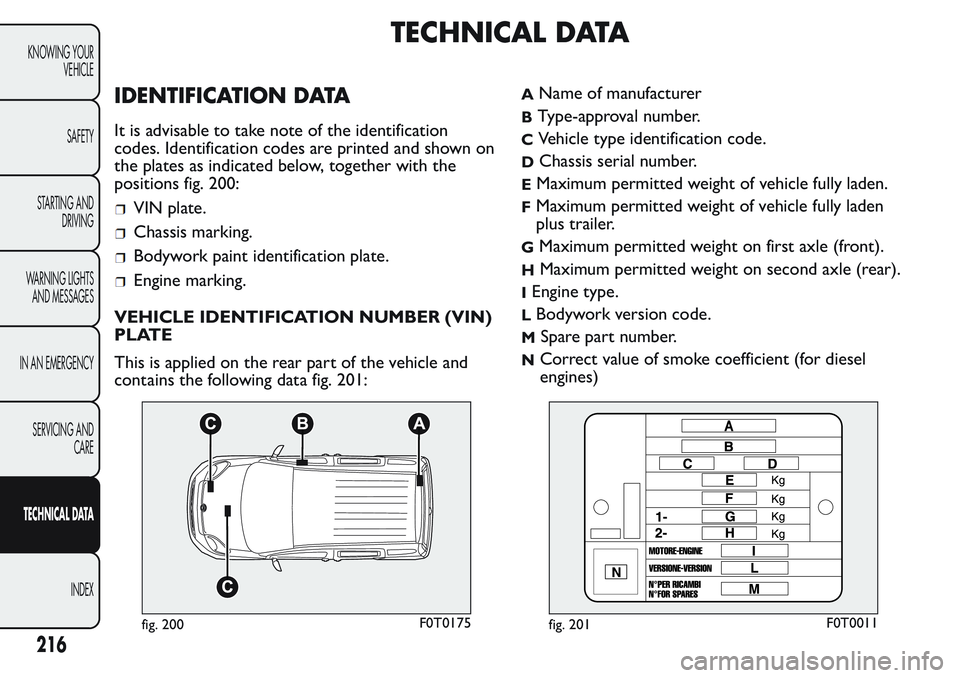
TECHNICAL DATA
IDENTIFICATION DATA
It is advisable to take note of the identification
codes. Identification codes are printed and shown on
the plates as indicated below, together with the
positions fig. 200:
VIN plate.
Chassis marking.
Bodywork paint identification plate.
Engine marking.
VEHICLE IDENTIFICATION NUMBER (VIN)
PLATE
This is applied on the rear part of the vehicle and
contains the following data fig. 201:
AName of manufacturer
BType-approval number.
CVehicle type identification code.
DChassis serial number.
EMaximum permitted weight of vehicle fully laden.
FMaximum permitted weight of vehicle fully laden
plus trailer.
GMaximum permitted weight on first axle (front).
HMaximum permitted weight on second axle (rear).
IEngine type.
LBodywork version code.
MSpare part number.
NCorrect value of smoke coefficient (for diesel
engines)
fig. 200F0T0175fig. 201F0T0011
216
KNOWING YOUR
VEHICLE
SAFETY
STARTING AND
DRIVING
WARNING LIGHTS
AND MESSAGES
IN AN EMERGENCY
SERVICING AND
CARE
TECHNICAL DATA
INDEX
Page 221 of 272
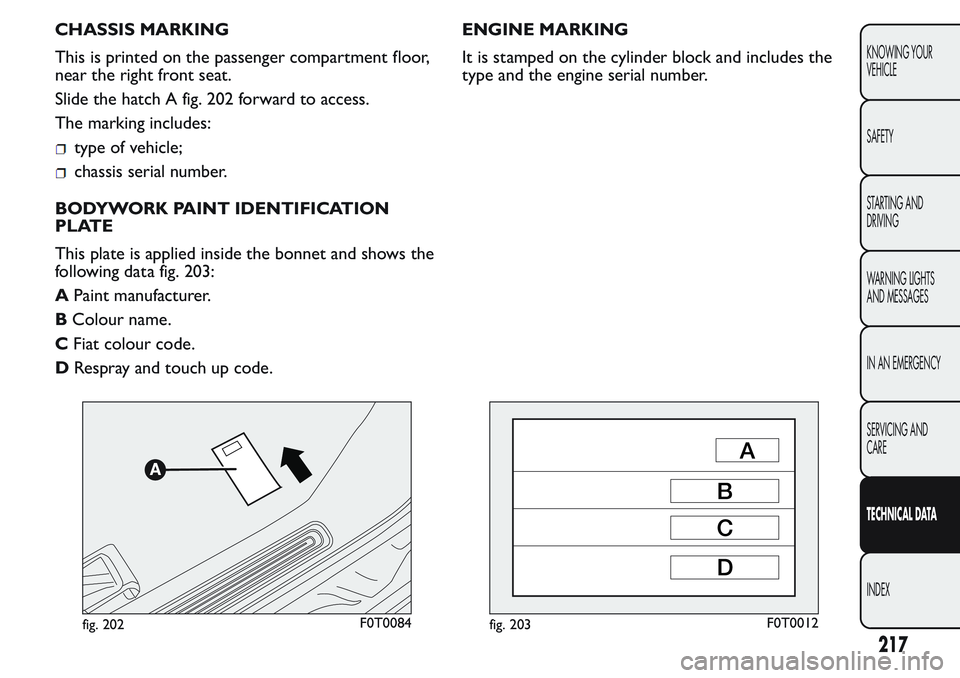
CHASSIS MARKING
This is printed on the passenger compartment floor,
near the right front seat.
Slide the hatch A fig. 202 forward to access.
The marking includes:
type of vehicle;
chassis serial number.
BODYWORK PAINT IDENTIFICATION
PLATE
This plate is applied inside the bonnet and shows the
following data fig. 203:
APaint manufacturer.
BColour name.
CFiat colour code.
DRespray and touch up code.ENGINE MARKING
It is stamped on the cylinder block and includes the
type and the engine serial number.
fig. 202F0T0084fig. 203F0T0012
217
KNOWING YOUR
VEHICLE
SAFETY
STARTING AND
DRIVING
WARNING LIGHTS
AND MESSAGES
IN AN EMERGENCY
SERVICING AND
CARE
TECHNICAL DATA
INDEX
Page 222 of 272
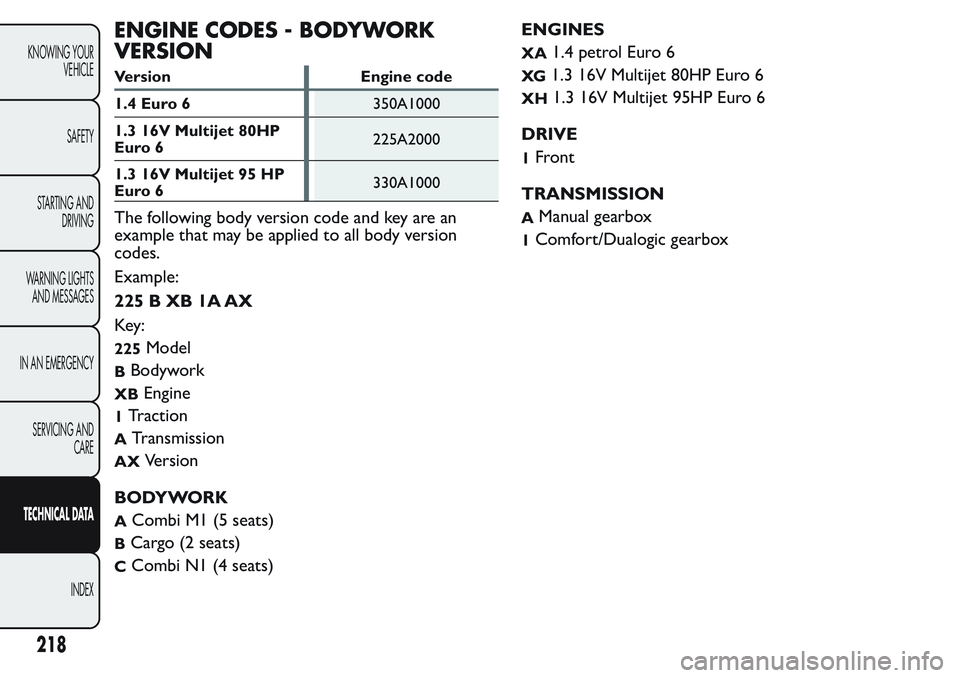
ENGINE CODES - BODYWORK
VERSION
Version Engine code
1.4 Euro 6350A1000
1.3 16V Multijet 80HP
Euro 6225A2000
1.3 16V Multijet 95 HP
Euro 6330A1000
The following body version code and key are an
example that may be applied to all body version
codes.
Example:
225BXB1AAX
Key :
225Model
BBodywork
XBEngine
1Traction
ATransmission
AXVersion
BODYWORK
ACombi M1 (5 seats)
BCargo (2 seats)
CCombi N1 (4 seats)ENGINES
XA1.4 petrol Euro 6
XG1.3 16V Multijet 80HP Euro 6
XH1.3 16V Multijet 95HP Euro 6
DRIVE
1Front
TRANSMISSION
AManual gearbox
1Comfort/Dualogic gearbox
218
KNOWING YOUR
VEHICLE
SAFETY
STARTING AND
DRIVING
WARNING LIGHTS
AND MESSAGES
IN AN EMERGENCY
SERVICING AND
CARE
TECHNICAL DATA
INDEX
Page 223 of 272
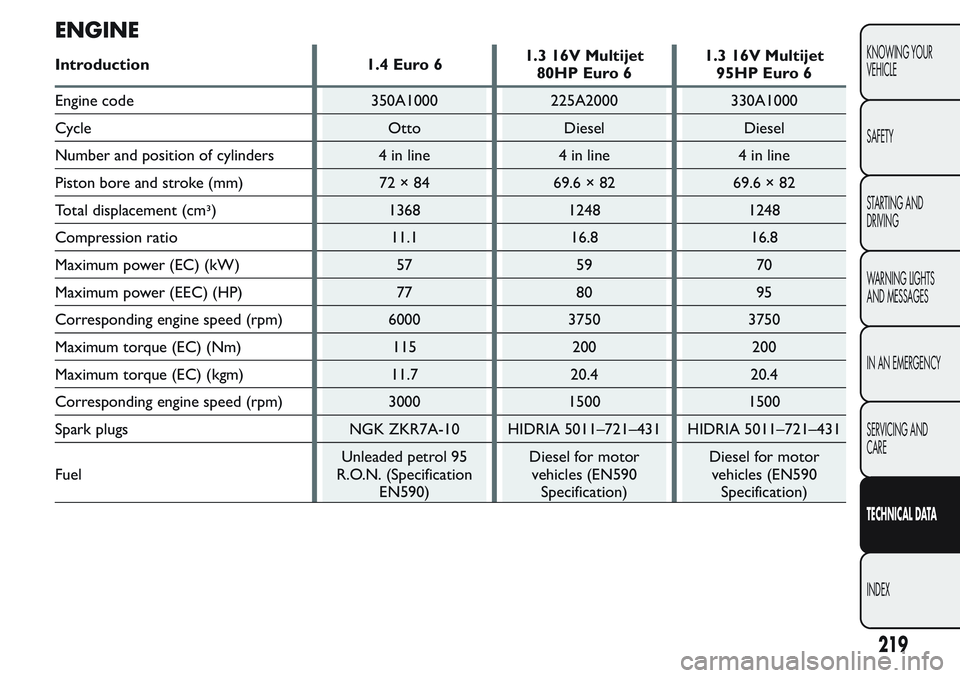
ENGINE
Introduction 1.4 Euro 61.3 16V Multijet
80HP Euro 61.3 16V Multijet
95HP Euro 6
Engine code 350A1000 225A2000 330A1000
Cycle Otto Diesel Diesel
Number and position of cylinders 4 in line 4 in line 4 in line
Piston bore and stroke (mm) 72 × 84 69.6 × 82 69.6 × 82
Total displacement (cm3) 1368 1248 1248
Compression ratio 11.1 16.8 16.8
Maximum power (EC) (kW) 57 59 70
Maximum power (EEC) (HP) 77 80 95
Corresponding engine speed (rpm) 6000 3750 3750
Maximum torque (EC) (Nm) 115 200 200
Maximum torque (EC) (kgm) 11.7 20.4 20.4
Corresponding engine speed (rpm) 3000 1500 1500
Spark plugs NGK ZKR7A-10 HIDRIA 5011–721–431 HIDRIA 5011–721–431
FuelUnleaded petrol 95
R.O.N. (Specification
EN590)Diesel for motor
vehicles (EN590
Specification)Diesel for motor
vehicles (EN590
Specification)
219
KNOWING YOUR
VEHICLE
SAFETY
STARTING AND
DRIVING
WARNING LIGHTS
AND MESSAGES
IN AN EMERGENCY
SERVICING AND
CARE
TECHNICAL DATA
INDEX
Page 224 of 272

POWER SUPPLY
Versions Power supply
1.4 Euro 6 Multipoint sequential timed electronic injection, returnless system
1.3 16V Multijet Euro 6Electronically controlled Common Rail MultiJet direct injection with turbocharger and
intercooler
WARNING
Modifications or repairs to the supply system that are not carried out correctly or do not
take the system technical specifications into account can cause malfunctions leading to the
risk of fire.
220
KNOWING YOUR
VEHICLE
SAFETY
STARTING AND
DRIVING
WARNING LIGHTS
AND MESSAGES
IN AN EMERGENCY
SERVICING AND
CARE
TECHNICAL DATA
INDEX
Page 225 of 272
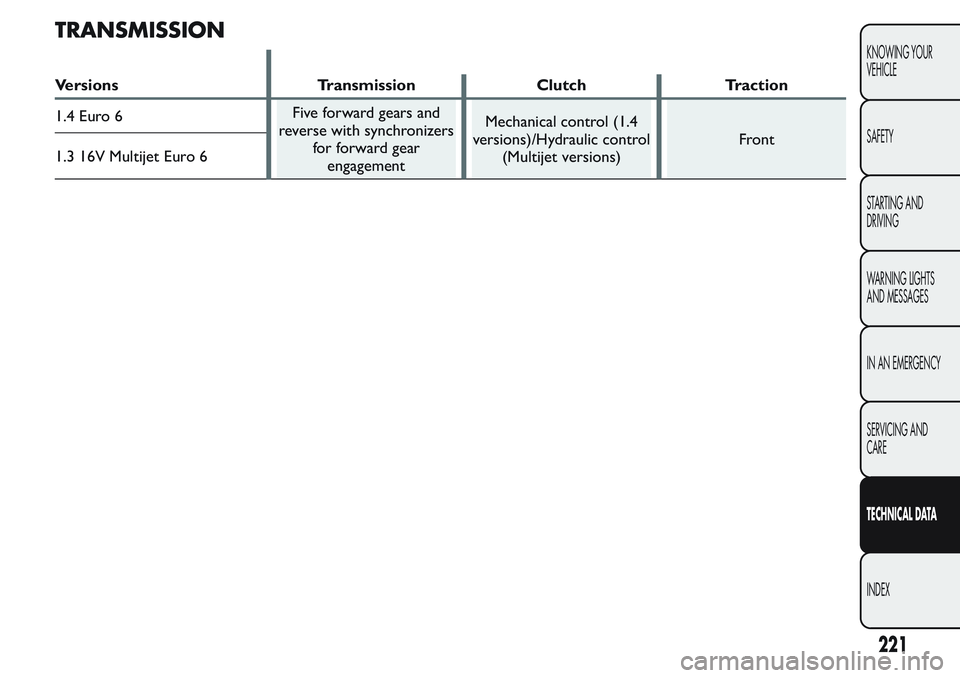
TRANSMISSION
Versions Transmission Clutch Traction
1.4 Euro 6Five forward gears and
reverse with synchronizers
for forward gear
engagementMechanical control (1.4
versions)/Hydraulic control
(Multijet versions)Front
1.3 16V Multijet Euro 6
221
KNOWING YOUR
VEHICLE
SAFETY
STARTING AND
DRIVING
WARNING LIGHTS
AND MESSAGES
IN AN EMERGENCY
SERVICING AND
CARE
TECHNICAL DATA
INDEX